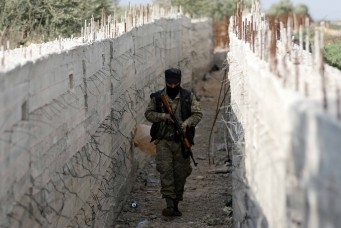Historical Developments Visible in Turkey-Syria
The events Monday transcend domestic Turkish issues. In fact, they reflect the convergence of at least five important new trends in the Middle East that touch on Turkey, the Kurds, Syria and Iraq, the Islamic State in Iraq and Syria (ISIS), and the Mideast policies of the United States and other foreign and regional powers.
The four separate armed attacks Monday against Turkish security forces and the U.S. Consulate in Istanbul are all repeat performances of similar attacks in recent years, so we can easily see this as simply another rough day for Turkey but not a pivotal moment of any sort. The situation deserves a closer look, I would argue, because the events Monday transcend domestic Turkish issues. In fact, they reflect the convergence of at least five important new trends in the Middle East that touch on Turkey, the Kurds, Syria and Iraq, the Islamic State in Iraq and Syria (ISIS), and the Mideast policies of the United States and other foreign and regional powers. This convergence of multiple interests and actions on the ground in Turkey-Syria is replicated in different forms elsewhere; it is likely to keep shaping developments across the Middle East for a few years to come, until the region settles into a new and more sustainable condition.
The attacks Monday were carried out by the Marxist Turkish group called the Revolutionary People’s Liberation Party-Front (RPLPF), and the Kurdistan Workers’ Party (PKK), both of whom have been battling the Turkish government and security forces for years. The new development that deserves our attention and resonates regionally is the convergence of this internal Turkish-Kurdish battle with the five new factors that shape developments in the region: the fragmentation and partial collapse of existing states like Iraq and Syria, the emergence of a de facto Kurdish state in northern Iraq and Syria, the persistence of the new “Islamic State’ that ISIS has created in northern Syria and Iraq, the muscular regional militarism of local powers like Turkey, Iran and Saudi Arabia, and the continued incoherence of American foreign policy in the region.
Each one of these factors emerges from its own historical context, but together they create a dynamic and often contradictory situation that defies easy analysis. The most confusing element is about who are friends and enemies in this situation, because the allies and foes of the United States, Turkey, Syrian rebel groups, the Syrian government, and ISIS do not always line up neatly. So while the United States and Turkey both classify the PKK as a terrorist group, the PKK’s Kurdish ally in northern Syria, the People’s Protection Units (YPG) with its 30,000 or more fighters, is the most effective fighting force on the ground against ISIS. The YPG forces have worked closely with the United States and others to push back ISIS in several strategic parts of northern Syria, including Kobani, Tel Abyad and Hassaka.
Similarly, the United States opposes Iranian-linked militias in Iraq, but those militias are among the most effective ground forces in the fight against ISIS in central Iraq. The United States and Hezbollah are deeply antagonistic to each other, but in their common fight against ISIS and Jabhat Al-Nusra forces in western Syria, they line up on the same side.
The common denominator among these different dynamics is the testing and reconfiguration of a few existing states in the region, and the assertion of identities by groups of people who are not satisfied with the existing sovereign order that has defined the Middle East for the past century or so. Syria and Iraq are the most glaring examples of states that are fragmenting, opening the way for the two most important immediate developments: the birth of ISIS’ “Islamic State” and the expansion of Kurdish-controlled lands that have become a proto-state. The “Islamic State” will not last, and a de jure Kurdish sovereign state will probably come into being in the decades ahead.
When a big regional power like Turkey starts throwing around its military muscle, a big global power like the United States continues to use its military might as a routine policy tool in the region, and governments like the one in Syria viciously attack their own civilians, we should not be surprised that existing state orders start to shake and collapse. This creates openings for new local powers and even novel state authorities to take root, as in the Kurdish and ISIS situations. This is further complicated by the fact that we do not have a clear idea of who would assume power if and when the Assad government falls in Damascus, which brings into play the interests and active military involvement of the Iranian government and Hezbollah in Lebanon.
Given the weak performance of most Arab states in the past century, we should expect to see more such situations where fragmenting states, assertive regional powers, and militarized global powers come together and take action, often in contradictory ways. This reaffirms the old American political saying that all politics is local, since in these cases we see local identities and interests driving the situations, and forcing regional and global powers to react.
Rami G. Khouri is published twice weekly in the Daily Star. He was founding director and now senior policy fellow of the Issam Fares Institute for Public Policy and International Affairs at the American University of Beirut. On Twitter @ramikhouri.
Copyright ©2015 Rami G. Khouri — distributed by Agence Global



